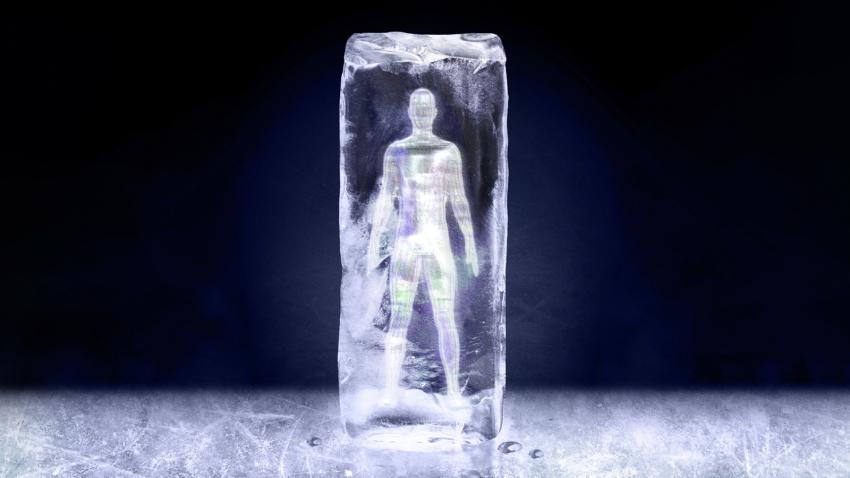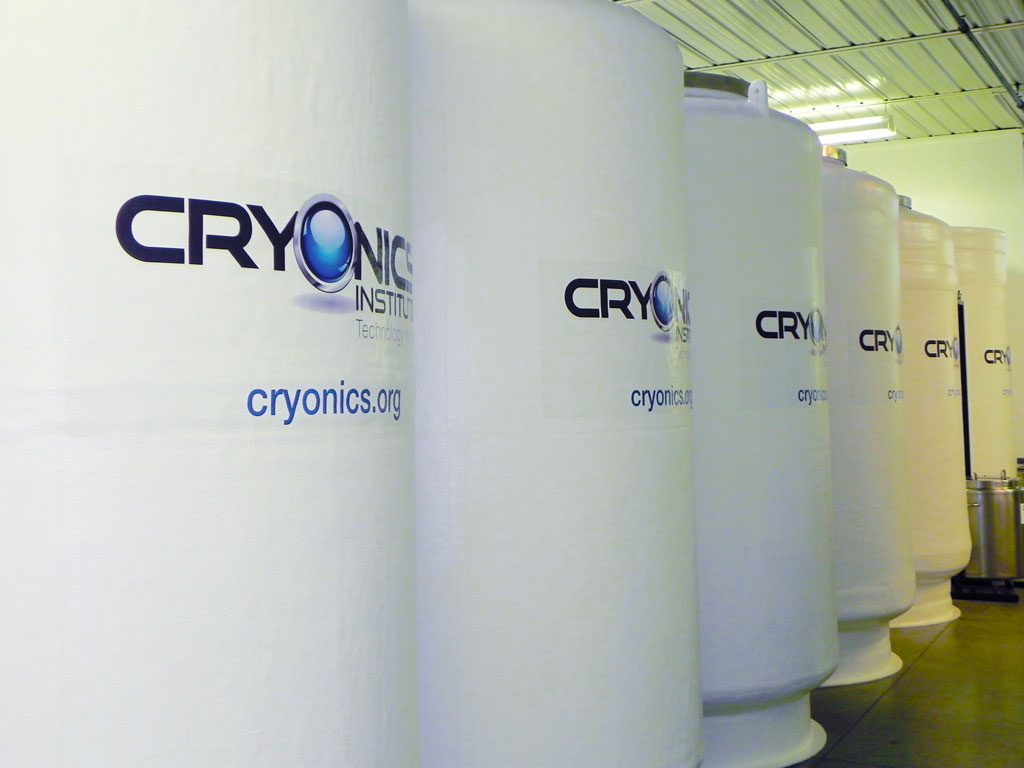What ever happened to the first cryogenically frozen humans?

Several facilities in the U.S. and abroad maintain morbid warehouse morgues full of frozen human heads and bodies, waiting for the future. They are part of a story that is ghoulish, darkly humorous, and yet endearingly sincere. For a small group of fervent futurists, it is their lottery ticket to immortality. What are the chances that these bodies will be reanimated? Will baseball legend Ted Williams’ frozen head be awakened to coach fighter pilots or fused to a robot body to hit .400 again?
A primer on cryonics
Cryonics — attempting to cryopreserve the human body — is widely considered a pseudoscience. Cryopreservation is a legitimate scientific endeavor in which cells, organs, or in rare cases entire organisms may be cooled to extremely low temperatures and revived somewhat intact. It occurs in nature, but only in limited cases.
Humans are particularly difficult to preserve because of the delicate structure in (most of) our heads. Deprived of oxygen at room temperature, the brain dies within minutes. While the body may be reanimated, the person who “lives” is often in a permanent vegetative state. Cooling the body may give the brain a bit more time. During brain or heart surgery, circulation may be stopped for up to an hour with the body cooled to 20° C (68° F). A procedure to cool the body to 10° C (50 F°) without oxygen for additional hours is still at the experimental research stage.
After a while, he let the bodies thaw out inside the capsule and left the whole thing festering in his vault.
When a cryonic patient dies, a race begins to prepare and cool the body before it decays and then to place it inside a Dewar: a thermos bottle full of liquid nitrogen (LN). The inner vessel of the Dewar contains a body, or bodies, wrapped in several layers of insulating material, attached to a stretcher, and suspended in LN. The head is oriented downward to keep the brain the coldest and most stable.
This vessel lies within a second outer vessel, separated by a vacuum to avoid heat transfer from the outer room-temperature vessel wall to the cold inner vessel wall. Heat gradually transfers across anyway and boils away the LN, which must be periodically refilled. Bodies were originally, and may still be in some cases, cooled and frozen in whatever condition they were in at death, with better or worse preservation, as we shall see.
The grisly fates of the first cryonauts
The early years of cryonics were grisly. All but one of the first frozen futurists failed in their quest for immortality.
Small freezing operations began in the late 1960s. While the practice of storing bodies has become more sophisticated over the past 50 years, in the early days, technicians cooled and prepared corpses with haste on dry ice before eventually cramming them into Dewar capsules. By and large, these “preservations” did not achieve preservation. They were nightmarish, gruesome failures. Their stories were researched and documented by people within the field, who published thorough and frank records.
The largest operation was run out of a cemetery in Chatsworth, California by a man named Robert Nelson. Four of his first clients were not initially frozen in LN but placed on a bed of dry ice in a mortuary. One of these bodies was a woman whose son decided to take her body back. He “hauled (his dead mother) around in a truck” on dry ice for some time before burying her.
The bodies in the container partially thawed, moved, and then froze again — stuck to the capsule like a child’s tongue to a cold lamp post.
Eventually, the mortician was not pleased with the other bodies sitting around on beds of ice, so a LN Dewar capsule was secured for the remaining three. Another man was already frozen and sealed inside the capsule, so it was opened, and he was removed. Nelson and the mortician then spent the entire night figuring out how to jam four people — who may or may not have suffered thaw damage — into the capsule. The arrangement of bodies in different orientations was described as a “puzzle.” After finding an arrangement that worked, the resealed capsule was lowered into an underground vault at the cemetery. Nelson claimed to have refilled it sporadically for about a year before he stopped receiving money from the relatives. After a while, he let the bodies thaw out inside the capsule and left the whole thing festering in his vault.
Another group of three, including an eight-year-old girl, was packed into a second capsule in the Chatsworth vault. The LN system of this capsule subsequently failed without Nelson noticing. Upon checking one day, he saw that everyone inside had long thawed out. The fate of these ruined bodies is unclear, but they might have been refrozen for several more years.
Nelson froze a six-year-old boy in 1974. The capsule itself was well maintained by the boy’s father, but when it was opened, the boy’s body was found to be cracked. The cracking could have occurred if the body was frozen too quickly by the LN. The boy was then thawed, embalmed, and buried. Now that there was a vacancy, a different man was placed into the leftover capsule, but ten months had elapsed between his death and freezing, so his body was in rotten shape — no pun intended — from the get-go and was eventually thawed.
Every cryonic client put into the vault at Chatsworth and looked after by Nelson eventually failed. The bodies inside the Dewar capsules were simply left to rot. Reporters visited the crypt where these failed operations had taken place and reported a horrifying stench. The proprietor admitted to failure, bad decisions, and going broke. He further pointed out, “Who can guarantee that you’re going to be suspended for 10 or 15 years?”
The worst fates of all occurred at a similar underground vault that stored bodies at a cemetery in Butler, New Jersey. The storage Dewar was poorly designed, with uninsulated pipes. This led to a series of incidents, at least one of which was failure of the vacuum jacket insulating the inside. The bodies in the container partially thawed, moved, and then froze again — stuck to the capsule like a child’s tongue to a cold lamp post. Eventually the bodies had to be entirely thawed to unstick, then re-frozen and put back in. A year later, the Dewar failed again, and the bodies decomposed into “a plug of fluids” in the bottom of the capsule. The decision was finally made to thaw the entire contraption, scrape out the remains, and bury them. The men who performed this unfortunate task had to wear a breathing apparatus.
The state of cryonics today
Out of all those frozen prior to 1973, one body remains preserved. Robert Bedford was sealed into a Dewar in 1967. Instead of leaving the body to meet a horrific fate under Nelson’s care, Bedford’s family took custody of the capsule, meticulously caring for it at their own expense. The body was handed off between professional cryonics operations, occupying multiple frozen tanks and facilities for 15 years or so. Eventually it ended up in the hands of the founders of Alcor — a modern cryonics outfit — one of whom wrote a heartfelt, slightly creepy piece about the body.
Alcor is the leading example of the current state of cryonics. While the ugly events above suggest that your remains might well end up as tissue sludge scraped out of a can, the professionalism of companies like Alcor may offer an increased chance for long-term preservation. This 501(c)(3) organization hosts researchers who work on methods to improve the freezing process, possibly increasing whatever slight odds exist that human popsicles will ever be brought back to life. At a more fundamental level, it appears to be stable and to have deep pockets, so there is a better chance that your corpse will be around long enough for some distant future doctor to recoil in horror at it.

The U.S. industry has consolidated around two main organizations. If not Alcor, your other choice is the Cryonics Institute, which has more than 200 bodies stored in giant tanks and accepts dozens more each year. Apparently, ten years ago, head storage alone at Alcor cost $80,000, while full body storage at the Cryonics Institute was only $30,000. There are international options as well. A Russian cryogenics company stores not only people but pets, including one entry under rodents, a deceased chinchilla named Button.
Modern cryonic preparations at Alcor employ a multistep process to prepare the body for storage. First, they begin to cool the body while anti-clotting agents and organ preservation solutions are injected into the bloodstream and circulated under CPR. The body is then transported to the company’s main facility, where the original fluid is replaced with chemicals that vitrify — turn to glass — the body’s organs. This offers some hope for cutting down on structural damage during the subsequent cooling and storage. Then the body is entombed in its Dewar capsule.
Is cryonics science — or making human popsicles?
That all sounds scientific and careful. But is it really science or just applying scientific tools to a fantasy proposition? Is it possible to freeze the human body and revive it decades later? Currently, it’s not remotely plausible. Will it ever be? That’s probably an open question. As it stands now, cryonics is a bizarre intersection of scientific thinking and wishful thinking.
While cryonic preparation is now more advanced, the laws of physics demand that the structure of the body will break down — rapidly after death, catastrophically upon freezing, and gradually over time, even while frozen. Think of how badly frozen food ages in your freezer. If the medical technology of the future becomes advanced enough, perhaps these corpses can be revived. But that’s a big “if.” Let’s say your body remains frozen until the 25th century. Then, let’s say that future doctors are interested in reviving you. How much work will they have to do to fix you once you’re thawed? The answer lies in the condition of the bodies once they’re thawed. Strangely enough, we know something about this.
In 1983, Alcor needed to lighten three cryonauts, reducing them from bodies to simply heads. (In one transhumanist conception of the future, medical science will be able to revive the brain and then simply make a new body or robot to which to attach it. Neuropreservation is cheaper and easier too.) The three corpses were removed from their Dewar capsules so that the heads could be cut off — still frozen, so requiring a chainsaw — and stored separately. Once the heads were sawed off and put away, Alcor employees got to work medically examining the state of the bodies. They wrote up their findings in great detail.
At first, things looked reasonably good. While the bodies were still frozen, their skin was only moderately cracked in a few places. But once the bodies thawed, things started to go downhill.
The organs were badly cracked or severed. The spinal cord was snapped into three pieces and the heart was fractured.
Cracks appeared in the warming bodies, cutting through the skin and subcutaneous fat, all the way down to the body wall or muscle surface beneath. One patient displayed red traces across the skin following the paths of blood vessels that ruptured. Two of the patients had “massive cutaneous ruptures over the pubis.” The soft skin in these areas was apparently quite susceptible to cracking.
While the external damage was extensive, the internal damage was worse. Nearly every organ system inside the bodies was fractured. In one patient, every major blood vessel had broken near the heart, the lungs and spleen were almost bisected, and the intestines fractured extensively. Only the liver and kidneys weren’t completely destroyed.
The third body, which had been thawed very slowly, was in better condition externally, with only a few skin fractures and no obvious exploded blood vessels. However, the inside was even more annihilated than the others. The organs were badly cracked or severed. The spinal cord was snapped into three pieces and the heart was fractured. The examiners injected dye into an artery in the arm. Rather than flow through blood vessels and into muscles, most of it pooled under the surface in pockets and leaked out of skin fractures.
The medical examiners extensively detailed the content of the blood, the texture of the muscles, and the extent of the damage. They included pictures. And they earnestly stated their conclusion up front: The tremendous tissue deterioration will require incredibly advanced medical technology to fix. Worse, the probable destruction at the cellular level may require rebuilding the body at the molecular level. Perhaps future medicine might be able to inject swarms of nanobots into your body to repair every bit of tissue, but don’t bet on it happening any time soon.
Watch out for crazy relatives
Modern cryonics practices may ward off the horrific failures of the past. And we can’t entirely rule out future medicine somehow finding fixes for the terrific damage incurred by the body in freezing, sitting, and thawing. But there’s one more hurdle for the future revivification of your frozen form, the last great danger to your immortality: your crazy relatives. Several cases demonstrate the problem.
The family of a man frozen in 1978 eventually got tired of paying for him. The facility offered to cut off his head and store it for free, but the family turned them down. Instead, the body was thawed, submerged in a vat of formaldehyde like a laboratory specimen, and buried in that condition. Two further men were stored by their sons, one of whom had his father thawed, removed, and buried. The other son eventually buried his dad’s capsule in its entirety with the remains still inside.
Relatives can also go to court and battle over what happens to your corpse. Richard Orville’s family buried him against his wishes and was eventually forced by an Iowa court to dig up his body for preservation. A Colorado woman’s family went to court to fight Alcor for their mother’s head. Alcor eventually got the head, to preserve as best they could. Conversely, another woman’s will stated that she did not want to be frozen. Her husband froze her anyway, and after a four-year court battle, the State of California ordered that she be thawed and buried.
One particularly well-known family affair is the story of a frozen Norwegian man who was initially stored at a California facility that worked with Alcor. He was removed by his daughter, who stored him in an ice shed behind her house in Colorado. The body was discovered when she was evicted from the property. The small town of Nederland, Colorado now has a Frozen Dead Guy Days celebration every year.
Cryo-fiction
While the chances of immortality may be slim, dozens of people still commit their bodies or brains to cryonics each year. If their remains aren’t mismanaged or allowed to disintegrate, and if their relatives don’t go to court over the body, there is now a good chance that they will remain frozen for decades. Unfortunately, they will come out of the process cracked into a million pieces, and the prospect of putting them back together again is purely science fiction for the foreseeable future. It’s a grim practice with ghoulish results; at least it makes for some fascinating stories and a bit of dark humor.
This article was reprinted with permission of Big Think, where it was originally published.




















